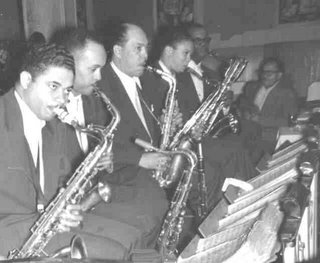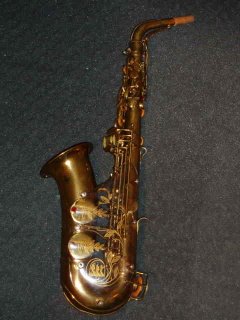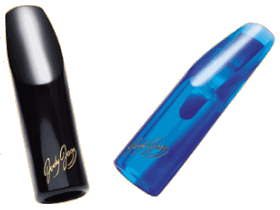Santy to Marshal to Jody

A little history here: For my 12th birthday my parents brought me to Disneyland, but not so I could ride the teacups, see the blinking eye in that Monsanto ride, or hurdle down the Matterhorn. The Basie band was playing. My dad knew what he was doing. I'd been playing the saxophone on school for a few months. Maybe he was thinking about lighting a fire under me so I'd be more serious about my practicing. So we got there early and settled down near the front, the better, it seems to me thinking about it 40 years later, to hear Marshal (one "l") Royal lead the saxophone section, and by extenstion the whole swinging band.

Marshal Royal played lead alto saxophone for the Count Basie Orchestra from 1951-1971. During this time, the Basie Band established itself as one of the definitive forces in big band jazz as it emerged from the embers of the Big Band era with the seemingly impossible combination of wild swinging abandon with textbook precision. That was Marshal's contribution, I later learned.
Marshal was born in Sapulpa, Oklahoma in 1921 and was raised in Los Angeles. His father taught music and led a band, his mother played piano, and his brother Ernie was a well-known jazz trumpteter. From the 1930's through the seventies he performed with Lionel Hampton, Earl Hines, and Duke Ellington, besides his time with Basie.
Needless to say, the Basie band, which was at the height of its powers--they had recently recorded "Live at the Sands" with Sinatra--touched me deeply. They put a hurtin' on me, as Joe Williams said. My father was an arranger, Dick Fenno, one whose best-selling chart was called "I Remember Basie." On their honeymoon night, my parents heard the Basie band at Storyville in Boston. I guess you could say I was genetically predisposed.

By the time I was 12, my dad's publishing business was going so well that my sister and I had after-school employment there, fulfilling orders, transcribing labels from school directories for the next mass mailing, and collating parts into complete arrangements. Our most frequent auditory companion on my father's Magnavox is a vinyl copy of "More Hits of the Fifties and Sixties."

A couple years ago I am spending some time basking in the light of Santy Runyon. We are talking about how the 28M, an innovative horn he had a lot to do with the design of when he worked for Conn just before World War II. I knew that part of Marshal's thing was 28M. Santy tells me that Marshal, whose sound has never left my brain since he drilled a hole into my head when I was 12, had a specially modified Conn Comet he played with his 28M. The original design was pure Santy Runyon, the modificatons for Marshal by Santy Runyon. I love it when modest people stumble across a genuine achievement in their lives. In an autographed photo which Santy produced, Marshal's Conn Comet is the amber color of my grandfather's cigar holder. The shank is a bit long, probably a long lay.
At this time, Santy has an enthusiastic student flying down from New York to take lessons in the black art of mouthpiece modiification. I drive with my daughter to Lafayette, Louisiana for Santy's 94th birthday party and I meet Jody Espina, a hard-blowing post-Bop alto player on a mission to come up with completely new mouthpiece designs based on the best neglected designs of the past. At the time, nobody is more neglected than Santy, nor as generous with their knowlege.
The result of Jody learning the trade is that he owns JodyJazz, a mouthpiece company in Manhattan. Jodyjazz mouthpieces are played far and wide, and are based on a number of seemingly contrarian designs. I myslef play an ESP on baritone, a DV on tenor, and my favorite, my Sapphire (aka blue) JodyJazz Classic Alto Mouthpiece. I just love walking into a strange new musical experience (as so many are, here in Austin) with a blue mouthpiece on the end of my horn (especially now that my horn has abalone keywork), Because of the Spoiler, the little gizmo that sits inside the mouthpiece making a shortcut for the air, I feel like I actually have the edge on the old guys whose Comets could only play with one single sound. (Of course they didn't have to play at today's volumes either!) At $127, shipping free, this mouthpiece is a bargain. Not only that, Jody spells out a plan on his website whereby your credit card payment won't be processed if you decide it's not for you and send it back in a timely manner and in perfect condition.
One of the real advantages in dealing with Jody is Jody himself, who has much in the way of received and emperical knowlege and an encyclopediac level of recall for problems relating to mouthpieces. If you're having mouthpiece problems, he can suggest a solution.
Yes, they all laughed when I pulled out my JodyJazz Sapphire Blue Classic. But whether it's channeling Marshal Royal when I'm playing lead in a big band, or doing the full-tilt boogie with the Fenno Brothers wedding band, that's the mouthpiece that works best with my Saxgourmet Model 6 alto.



1 Comments:
Marshal never owned a 28m alto. He had a 6m tranny #245,xx. He bought it new and played it his entire career.
The photo above (with the Basie band) shows him blowing a Lelandais mouthpiece. He later switched to a Comet after the Lelandais broke. Ernie Wilkins (blowing 2nd alto in the photo) had the Comet first. He may have hipped Marshal to those pieces.
Willie Smith also played Lelandais mouthpieces. So did Benny Carter for a time. Frank Wess now plays one on tenor.
Post a Comment
<< Home